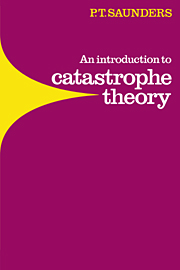Book contents
- Frontmatter
- Contents
- Preface
- 1 Introduction
- 2 Background
- 3 The seven elementary catastrophes
- 4 The geometry of the seven elementary catastrophes
- 5 Applications in physics
- 6 Applications in the social sciences
- 7 Applications in biology
- 8 Morphogenesis
- 9 Conclusions
- Exercises
- Appendix. Elementary catastrophes of codimension ≦ 5
- References
- Author index
- Subject index
8 - Morphogenesis
Published online by Cambridge University Press: 05 June 2012
- Frontmatter
- Contents
- Preface
- 1 Introduction
- 2 Background
- 3 The seven elementary catastrophes
- 4 The geometry of the seven elementary catastrophes
- 5 Applications in physics
- 6 Applications in the social sciences
- 7 Applications in biology
- 8 Morphogenesis
- 9 Conclusions
- Exercises
- Appendix. Elementary catastrophes of codimension ≦ 5
- References
- Author index
- Subject index
Summary
One of the most interesting – and difficult – problems in biology is that of understanding development, the process by which a fertilized egg becomes first an embryo and then a fully formed organism. And an important aspect of development is morphogenesis, the creation of the various forms characteristic of the organism and its constituent parts. Of course the problem of form and the succession of forms is encountered in other branches of science as well, but it is in developmental biology that it is especially important. How is it that out of a single cell there can develop an organism which is to such a large extent the same as all others of the same species? How is it that this can happen even though different individuals within a species may be quite different in size and in certain details of their shape? And how is it that the process is so stable, allowing considerable variation in the environment and resisting many (though by no means all) perturbations?
In seeking an answer to these questions, the first step is to try to establish exactly what it is that the developmental process accomplishes. In the language of the earlier chapters of this book, what do we mean when we say that two individuals are ‘of the same form’? It is clearly impossible to give a completely satisfactory definition, but the mathematical relation that most nearly captures the essential idea is that of topological equivalence.
- Type
- Chapter
- Information
- An Introduction to Catastrophe Theory , pp. 115 - 126Publisher: Cambridge University PressPrint publication year: 1980
- 1
- Cited by



